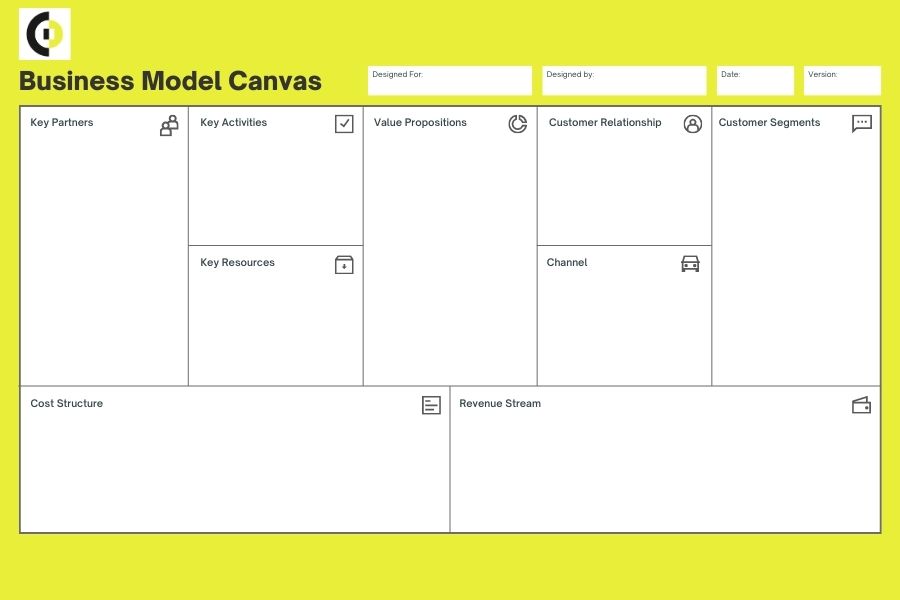The Business Model Canvas (BMC) can help you effectively define and communicate your business idea or concept. This strategic management tool simplifies the process by providing a concise, one-page document.
With the BMC, you can organize the fundamental elements of your business or product in a coherent structure that resonates with both external customers and internal operations. By focusing on the value proposition, which represents the exchange of value between your business and customers, you can develop a clearer understanding of your venture’s potential.
Why choose the BMC?
- Gain a visual overview of your idea’s core aspects.
- Understand the business’s viability and establish connections.
- Analyze customer decision-making and its impact on system utilization.
- Ensure all stakeholders have a clear understanding of your business concept.
Experience the benefits of the Business Model Canvas (BMC) to quickly and effectively convey your business idea and transform it into a successful venture.
Utilizing the Value Proposition for Effective Business/Product Development
Understanding the value proposition is crucial for the success of any business or product. The value proposition represents the core idea of value exchange between your business and your customers or clients. Typically, customers are willing to exchange money for a solution to their problems or the alleviation of their pain points provided by your business.
To define your business/product effectively, consider asking the following important questions:
- What specific problem am I addressing?
- What drives the desire for solving this problem?
- What motivates customers to seek a solution for this problem?
By incorporating these key considerations into your business or product development process, you can enhance your chances of delivering a valuable solution that meets customer needs and drives success.
Optimizing Customer Segmentation for Effective Marketing
Customer segmentation entails the division of your customer base into distinct groups categorized by specific similarities, such as age, gender, interests, and spending habits. This practice allows you to tailor your marketing efforts to effectively target each group.
To determine your customer segments, take into account the following considerations:
- Identify your target audience: Who are the individuals you are solving a problem or providing value to?
- Assess the value proposition: Which people are most likely to appreciate and benefit from your value proposition? Are they businesses or individuals? If they are businesses, what are the defining characteristics of these organizations? If they are individuals, does your value proposition appeal more to men, women, or both? Does it cater to young adults (ages 20 to 30) or teenagers? What are the common characteristics of people seeking your value proposition?
Another crucial aspect is understanding the size of your market and the number of individuals within each customer segment. This knowledge provides valuable insights into your market on both a micro and macro level.
Developing customer personas for each customer segment is an excellent starting point to gain a deeper understanding of your customers. By implementing effective customer segmentation strategies and utilizing customer personas, you can refine your marketing approach and successfully connect and interact with the specific group of customers you aim to attract and serve.
Nurturing Customer Relationships: Enhancing Interactions for Business Success
Now that we have a solid grasp of our value proposition and have crafted detailed personas to understand our customer segments let’s explore the essential aspect of customer relationships. This refers to how a business engages and interacts with its customers.
Consider the following factors when establishing customer relationships:
#1 Mode of Interaction
Determine the primary mode of interaction with your customers. Do you engage with them in person, via phone conversations, or predominantly online? The nature of your business operations will influence the type of relationship established.
Examples of customer relationship modes include:
- In-person meetings (one-to-one)
- Collaborating with third-party contractors
- Online engagement
- Hosting events (one-to-many)
- Phone interactions
#2 User Journey Mapping
Creating a user journey map is a valuable step in understanding how customers interact with your business. This visualization outlines the key touchpoints between you and your customers and the various modes employed to connect with them.
User Journey Mapping offers several benefits:
- Clarifies customer engagement points
- Identifies modes of communication with customers
- Helps shape your business operations
- Unveils opportunities for automation and optimization
By nurturing customer relationships through effective interactions, you can strengthen customer satisfaction, loyalty and ultimately drive business growth. Crafted with precision, your customer relationship strategy can pave the way for successful operations and uncover avenues for automation and enhanced efficiency.
Maximizing Channel Effectiveness: Reaching and Engaging Your Customers
Channels are vitally important in connecting your customers with your business and integrating them into your sales cycle. These channels are an essential component of your overall marketing plan.
To determine the most efficient channels for reaching your customers, consider the following key questions:
- How can we effectively communicate our value proposition to our customer segment?
- Where can we find our customers? Are they active on social media platforms? Do they listen to the radio while driving? Are they attending events or conferences? Do they watch TV on Friday nights at 7 pm?
Here are examples of diverse channels to consider:
- Social media platforms
- Email marketing campaigns
- Networking opportunities
- Search Engine Marketing (SEM)
- Search Engine Optimization (SEO)
- Viral marketing campaigns
- Targeting relevant blogs
- Sales and commission-based promotions
- Collaborating with affiliates
- Building online communities
- Offline advertising, such as billboards, TV, and radio spots
Understanding how to reach and engage your customers effectively is of utmost importance for the success of your business. You can maximize your customer outreach and drive business growth by strategically selecting and optimizing your channels.
Identifying Key Resources for Business Success
To ensure the smooth execution of your business activities, it is crucial to consider the practical resources required. These key resources encompass the necessary elements needed to carry out your business operations effectively.
Key resources refer to the essential assets your business relies on to function optimally. These resources are directly associated with the practical requirements for undertaking your business activities. Some examples of such resources include:
- Office space: A dedicated physical location to conduct your business operations.
- Computers: Essential hardware for performing various tasks and accessing digital resources.
- Hosting: Reliable hosting services to support your online presence and website.
- Personnel: Skilled and dedicated staff members to contribute to the business’s day-to-day functioning.
- Internet connection: A stable and high-speed internet connection for seamless online operations.
- Vehicles: Necessary transportation assets such as cars or bikes for logistics and mobility.
- Equipment: Specific tools or machinery required for your business operations.
- Utilities: Reliable access to electricity or other necessary utilities to power your business.
Identifying and securing these key resources enables your business to operate efficiently and meet customer demands. By ensuring these resources’ availability and proper utilization, you can enhance productivity, streamline processes, and ultimately drive business success.
Strategic Collaborations for Business Success: Identifying Key Partnerships
Key partnerships involve external companies, suppliers, or parties that are crucial in supporting your key activities and delivering value to your customers. These partnerships are essential when your business alone cannot achieve the intended value proposition.
Consider the following perspective: “If my business cannot independently fulfill the value proposition, who else do I need to collaborate with?”
Such partnerships are vital in achieving the value your business promises to deliver to customers. By identifying and nurturing strategic partnerships, you can enhance your business capabilities, expand your offerings, and fulfill customer expectations more effectively. Collaborating with key partners allows you to leverage their expertise, resources, or products, ultimately driving mutual success and customer satisfaction.
Optimizing Cost Structures: Managing Financial Aspects of Your Business
The cost structure of your business refers to the monetary expenses incurred in its operations. Understanding and effectively managing these costs are crucial for sustainable business performance.
Consider the following factors when assessing your cost structure:
- Cost of key activities: Determine the expenses associated with achieving your business’s key activities. How much does it cost to perform these essential tasks?
- Cost of key resources and partnerships: Evaluate the financial implications of acquiring and maintaining key resources and partnerships. What are the costs associated with these essential assets and collaborations?
- Cost of value proposition: Assess the expenses involved in delivering the value proposition to your customers/users. What are the costs of providing the promised value to your target audience?
- Additional business costs: Consider other expenses tied to running your business, such as legal fees and insurance coverage. These costs contribute to the overall financial obligations of your business.
- Valuing your time: Place a monetary value on your time as a cost. Consider how much it would cost to hire someone with your expertise and allocate an appropriate value to your own time.
- Opportunity cost: Understand the opportunity cost of running your business. Assess the potential benefits or profits you could have gained by choosing an alternative business venture.
By optimizing your cost structures, you can achieve financial efficiency, maximize profitability, and ensure the long-term viability of your business. Carefully managing expenses and valuing your time and resources contribute to making informed financial decisions and driving business success.
Maximizing Revenue Streams: Converting Value into Financial Gain
Revenue streams refer to the channels through which your business transforms its value proposition or solution to customer problems into financial profit. It is essential to price your offerings in a way that corresponds to customers’ perceived value in exchange for effectively resolving their pain points.
So, how can you generate revenue? Here are several revenue models to consider:
- Pay-per-product (Pay-per-view): Charging customers based on the usage or consumption of your products or services.
- Fee-for-service: Earning revenue by providing specific services for a predetermined fee.
- Fixed rate: Setting a fixed price for your offerings, regardless of usage or duration.
- Subscription: Offering customers ongoing access to your products or services in exchange for recurring payments.
- Dividends: Earning revenue through dividends or profit-sharing from investments or business ownership.
- Referral fees: Generating revenue by receiving a commission or fee for referring customers to other businesses or services.
- Freemium: Providing a basic version of your product or service for free, while offering advanced features or premium upgrades at a cost.
- Equity gain: Earning revenue through the appreciation of equity or ownership in a company.
You can optimize your financial returns and profitability by diversifying your revenue streams and selecting appropriate pricing models. Understanding the various options available allows you to align your revenue generation strategies with your business goals, customer preferences, and market dynamics.
To Sum Up
We hope our blog has helped you understand how the Business Model Canvas (BMC) simplifies business idea communication. It helps define key elements, understand customers, nurture relationships, optimize channels, manage costs, and maximize revenue streams. Experience the benefits of the BMC for your business success and long-term growth. Should you wish to read more about the powerful tools we use at Sipod, be sure to check out our blog.
Tags:





